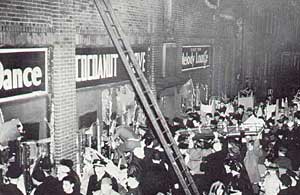Horizontal Sliding-Door Systems: Opening New Opportunities for Design Flexibility
The Triangle Shirtwaist Factory fire of 1911, in New York City, was an important turning point in the development of fire safety codes. Immigrant workers trying to flee the fire found the doors to the ninth-floor stairs in that Manhattan building to be locked, and the fire escape was flimsy. A total of 146 people died.
Another tragedy that assured strict standards for interior doors and emergency egress was the Cocoanut Grove fire in Boston in 1942, at a swank nightclub in what is now Bay Village, near the Theatre District in Boston. On a cold November night at about 10 p.m., with 1,000 patrons in the palm-tree lined halls, a young couple unscrewed a light bulb to soften the glow at their table. A bartender told a busboy to replace the light, who struck a match to better see what he was doing. The satin ceiling caught fire, and in moments, a fireball swept upstairs.
 |
| The Cocoanut Grove nightclub fire in Boston in 1942, which killed 492 people, led to strict standards on emergency egress and fire protection centered on the use of hinged swinging doors. |
As panic spread, the revolving door that was the primary entrance was hopelessly jammed, and others found side doors locked; 492 people died.
In the aftermath, cities across the nation revisited building codes and made sure evacuation in a fire emergency was paramount in any structure where large numbers of people gathered. One new requirement was that revolving doors could no longer be the primary means of egress, and had to have swinging doors on either side. Sliding doors and overhead doors could not be an exit. Emergency egress had to consist of hinged or pivoted doors, of a minimum width and height, that could be easily opened with minimal effort and that opened in the direction of exit travel.
The fire at the Our Lady of the Angels School in Chicago in 1958, in which 92 children and three nuns died, led to even tougher requirements for egress and fire protection in schools, and in hospital and healthcare facilities as well. The standards applied to museums, sports arenas, office buildings, and shopping and entertainment complexes-any building where large numbers of people gathered.
The standards were put in place both on the basis of performance and specifications, and spelled out in great detail in the three regional groups that promulgated model building codes: the Southern Building Code Congress International, covering southern and Gulf Coast states and producing the Standard Building Code; the Building Officials and Code Administration, covering the Northeast and Midwest and producing the National Building Code; and the International Conference of Building Officials, covering California and the West and producing the Uniform Building Code.
The other model code used by local jurisdictions was the National Fire Protection Association, which regulated key life safety elements such as sprinklers and alarms, and exits, windows, and doors.
Each of the regional groups had requirements for exit doors that differed slightly, based on the occupant "load," for example, the square footage of a building in proportion to the number of maximum allowed occupants. But the basic performance-based standard for a door that was to be used in an emergency was that it should not require any tool, key or special knowledge to open from the inside; and that it would take no more than 15 lbs. of pressure to open any latch, 30 lbs. of pressure to initiate the opening, and 15 lbs. of pressure to swing it open fully.
New rules were also set for the number of exits. Every accessible space had to have a minimum of one exit. Two exits were required in stores, hospitals, educational institutions, hotels, apartments, and office buildings where the occupancy ranged from 10 to 50, and two exits were also required for all floors with an occupancy of 10 or more. A minimum of three exits are required in buildings with an occupancy load of 501 or more, and a minimum of four are required where the occupancy load exceeds 1,001.
Similarly, the required width of exits broadened according to occupancy. The spacing of exits was based on the idea that occupants should not have to travel more than 200 to 300 feet to get to an exit in an emergency.









